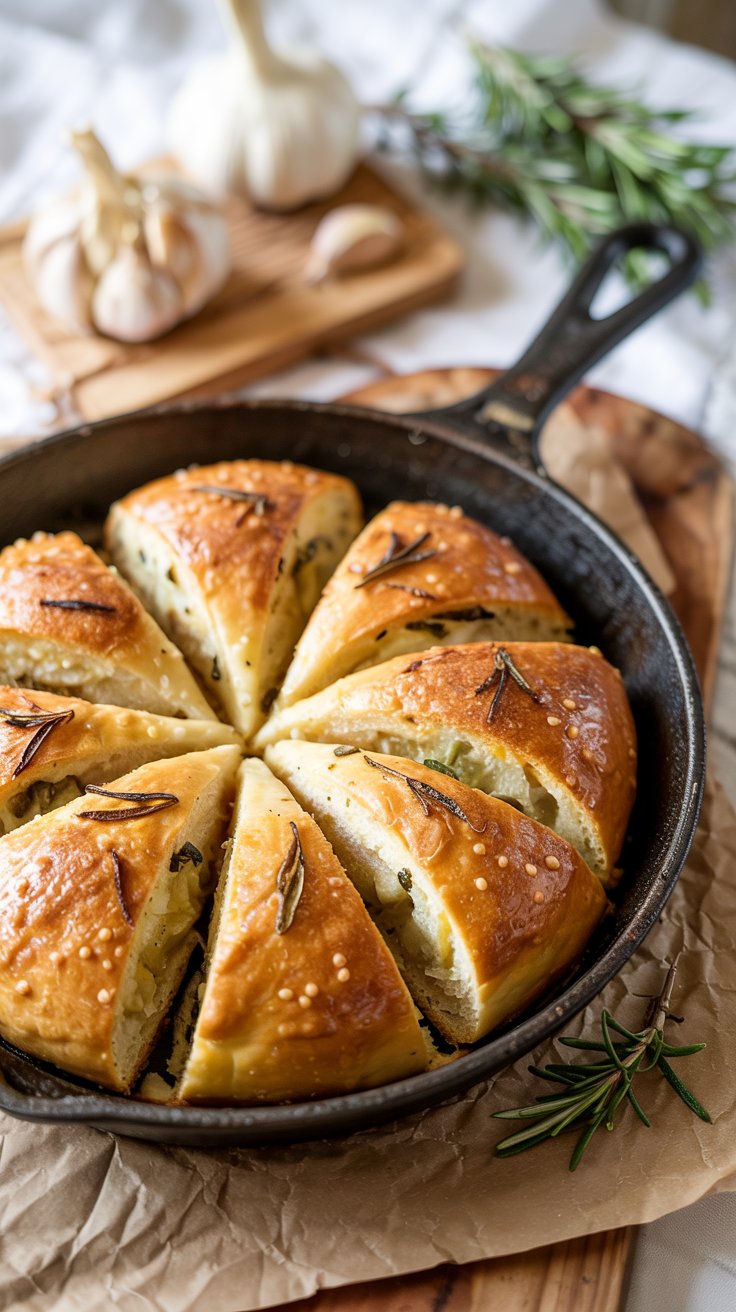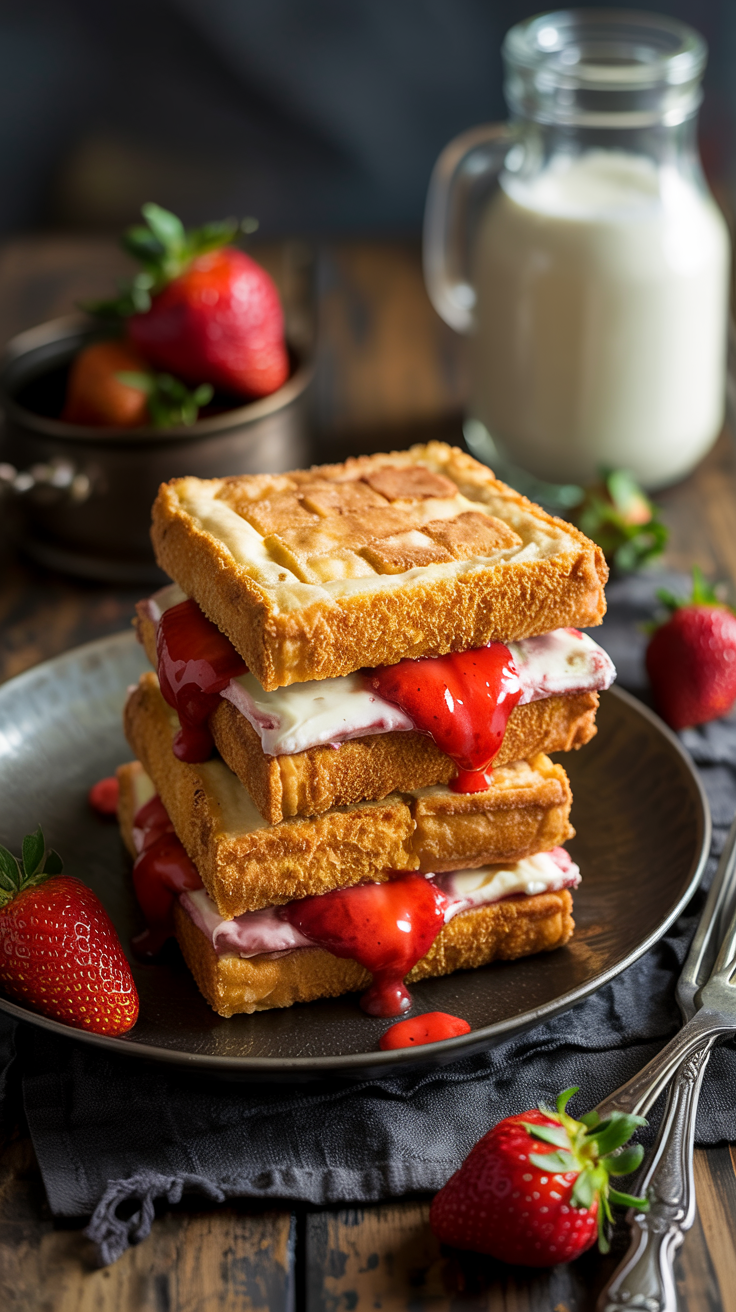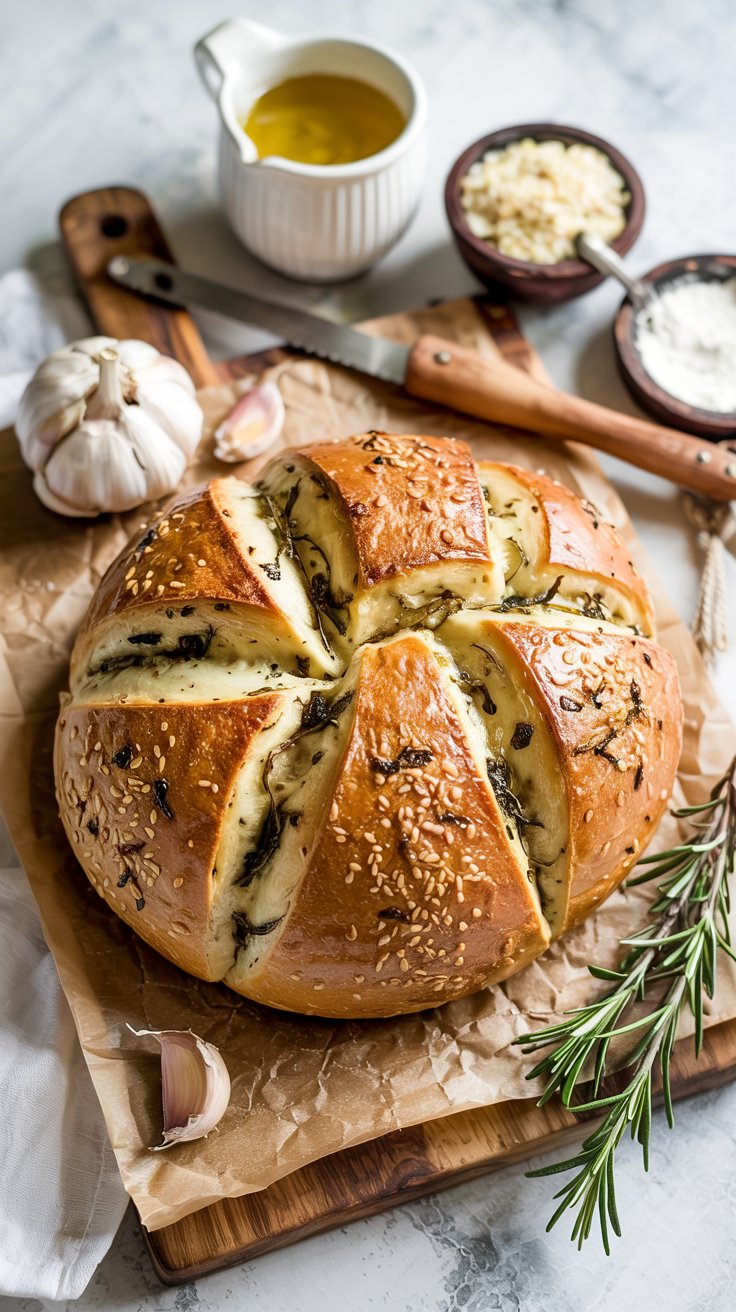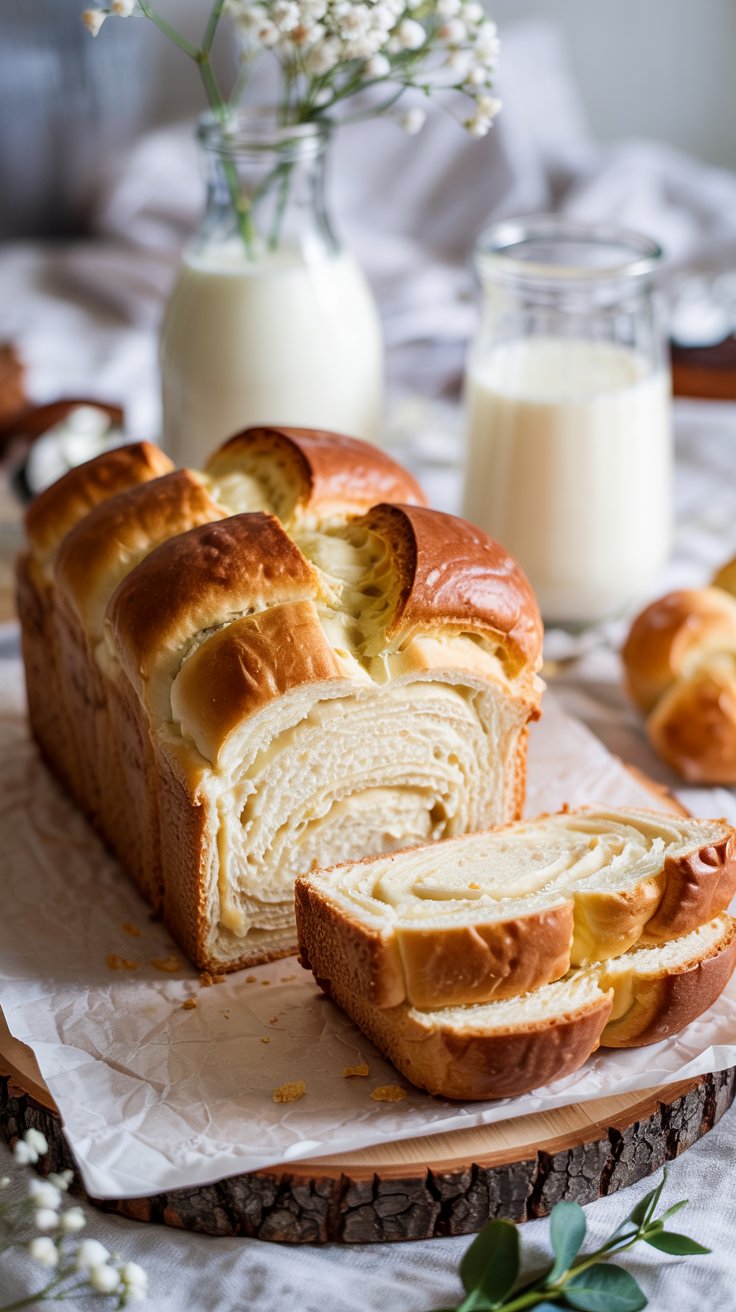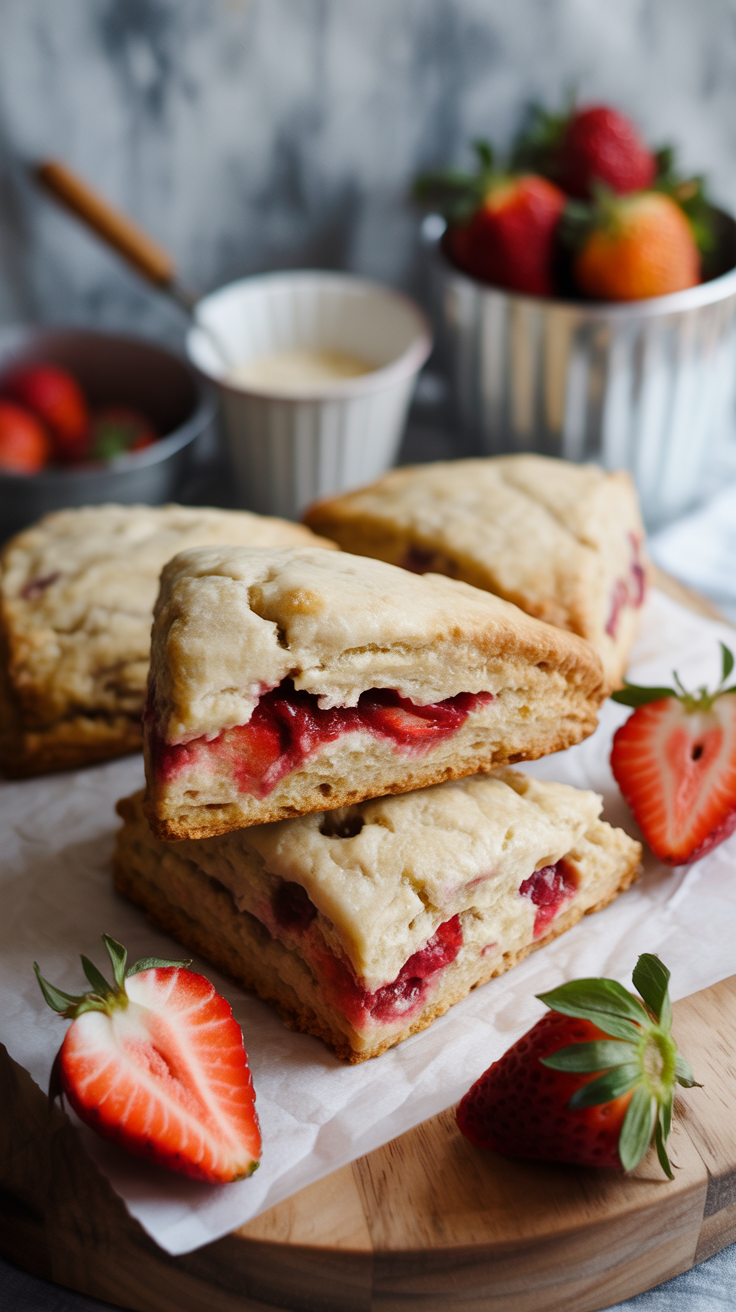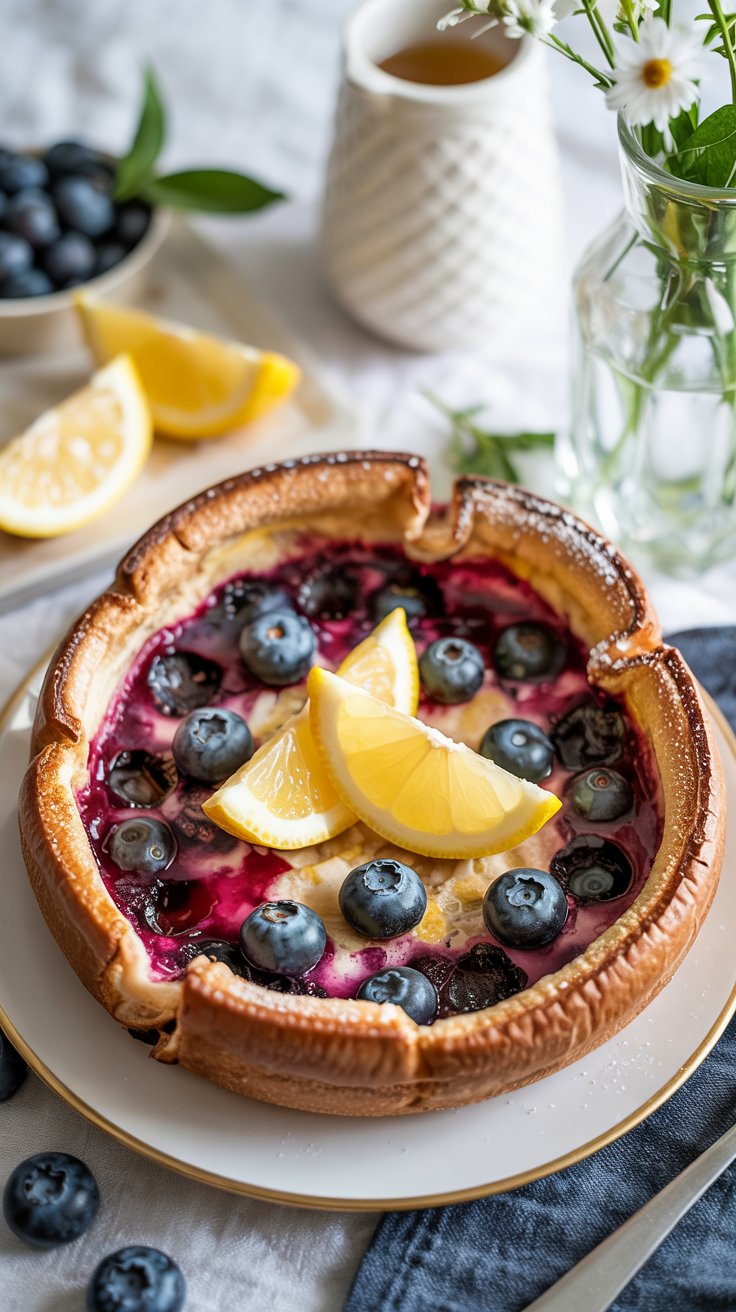Rustic Garlic Rosemary Skillet Bread
Rustic Garlic Rosemary Skillet Bread is the kind of loaf you make when you want something simple, warm, and dependable. Think golden edges, a soft middle, and those little pockets of garlicky rosemary that make the kitchen smell like comfort. This is a straightforward recipe you can pull together on a relaxed afternoon. No complicated techniques. Just a cast-iron skillet, a few pantry staples, and time to let the dough rise.
Ingredients for this Rustic Garlic Rosemary Skillet Bread
- 3 cups all-purpose flour, plus a little more for dusting (about 360 g)
- 1 cup warm water, plus 1 to 2 tablespoons if needed (about 240–255 ml, warm to the touch)
- 2 1/4 teaspoons active dry yeast (1 packet)
- 1 teaspoon sugar or honey
- 1 1/2 teaspoons fine sea salt
- 2 tablespoons olive oil for the dough
- 1 tablespoon olive oil for the skillet
- 3 to 4 garlic cloves, finely minced
- 2 tablespoons fresh rosemary, finely chopped
- 1 tablespoon olive oil or melted butter for brushing, optional
- Flaky sea salt for finishing, optional
Instructions
Wake up the yeast. In a large bowl, stir together the warm water, sugar, and yeast. Let it sit 5 to 10 minutes until it looks foamy on top. If nothing happens, the yeast may be old. Try again with a fresh packet.
Make the dough. Add 2 tablespoons olive oil and the salt. Stir in 2 cups of the flour until it forms a shaggy mass. Add the remaining cup of flour a bit at a time until the dough is soft and just slightly sticky. You might not need every last tablespoon.
Knead. Turn the dough onto a lightly floured surface and knead 5 to 7 minutes, until smooth and elastic. If using a stand mixer, a dough hook will do the job in about 4 to 5 minutes on medium-low.
First rise. Lightly oil a clean bowl, place the dough inside, and cover. Let it rise in a warm spot for 45 to 60 minutes, until doubled. It should feel airy, like a small pillow.
Prep the skillet and topping. Coat a 10 to 12 inch cast-iron skillet with 1 tablespoon olive oil. In a small bowl, mix the minced garlic, chopped rosemary, and 1 tablespoon olive oil (or melted butter). It’ll smell great already.
Shape. Gently deflate the dough and pat or stretch it into a round that fits the skillet. Place it in, then use your fingertips to dimple the top. Spoon the garlic-rosemary mixture over the surface, letting it settle into the dimples. Sprinkle with a pinch of flaky salt if you like.
Second rise. Loosely cover and let it rest 20 to 30 minutes, until puffy. During this time, preheat the oven to 425°F (220°C).
Bake. Bake 22 to 28 minutes, until the top is deep golden and the center reaches about 200 to 205°F if you check with a thermometer. If it’s browning too fast, loosely tent with foil for the last few minutes.
Finish and cool. Brush the hot bread with a little olive oil or melted butter for a soft sheen. Let it cool 10 to 15 minutes before slicing. It’s tempting to cut right in… but a short rest keeps the crumb tender.
Serve. Tear into wedges and pair with soup, a simple salad, or just olive oil and a pinch of salt. The edges will be crisp, the middle soft, and the garlic-rosemary bits will pop through each bite.
Cook and Prep Times
- Hands-on prep: about 20 minutes
- First rise: 45 to 60 minutes
- Second rise: 20 to 30 minutes
- Bake time: 22 to 28 minutes
- Cooling: 10 to 15 minutes
- Total time: roughly 2 to 2 1/2 hours
- Yield: 1 skillet loaf, about 10 to 12 wedges
Nutritional information
Approximate per slice, based on 10 slices and optional finishing oil included. Values will vary by brand and how thick you cut it.
- Calories: ~160
- Carbohydrates: ~24 g
- Protein: ~4 g
- Fat: ~5 g
- Saturated fat: ~1 g
- Fiber: ~1 g
- Sodium: ~330 mg
For lower sodium, reduce the salt in the dough slightly and skip the flaky salt on top.
Frequently asked questions
Can I use instant yeast instead of active dry yeast?
Use the same amount of instant yeast and skip the initial proofing step. Mix instant yeast directly with the flour and salt, then add warm water and oil. The rest stays the same. Rise times might be a touch faster, so keep an eye on the dough.
What if I don’t have a cast-iron skillet?
No problem. Use a well-oiled 9-inch round cake pan or an 8-by-8-inch metal pan. A heavy oven-safe pan works too. You’ll still get that crisp edge, though cast iron does it best. Start checking for doneness a couple minutes earlier since pans vary.
How do I store and reheat leftovers?
Let the bread cool completely, then store at room temperature in a paper bag or wrapped in a clean kitchen towel inside a loose plastic bag for up to 2 days. For longer storage, freeze sliced pieces in a zip bag. Reheat in a 350°F oven for 8 to 10 minutes, straight on the rack, until warmed through and lightly crisp.
Rustic Garlic Rosemary Skillet Bread
1
raciones20
minutes22
minutes160
kcalRustic Garlic Rosemary Skillet Bread is the kind of loaf you make when you want something simple, warm, and dependable. Think golden edges, a soft middle, and those little pockets of garlicky rosemary that make the kitchen smell like comfort. This is a straightforward recipe you can pull together on a relaxed afternoon. No complicated techniques. Just a cast-iron skillet, a few pantry staples, and time to let the dough rise.
Ingredients
3 cups all-purpose flour, plus a little more for dusting (about 360 g)
1 cup warm water, plus 1 to 2 tablespoons if needed (about 240–255 ml, warm to the touch)
2 1/4 teaspoons active dry yeast (1 packet)
1 teaspoon sugar or honey
1 1/2 teaspoons fine sea salt
2 tablespoons olive oil for the dough
1 tablespoon olive oil for the skillet
3 to 4 garlic cloves, finely minced
2 tablespoons fresh rosemary, finely chopped
1 tablespoon olive oil or melted butter for brushing, optional
Flaky sea salt for finishing, optional
Directions
- Wake up the yeast. In a large bowl, stir together the warm water, sugar, and yeast. Let it sit 5 to 10 minutes until it looks foamy on top. If nothing happens, the yeast may be old. Try again with a fresh packet.
- Make the dough. Add 2 tablespoons olive oil and the salt. Stir in 2 cups of the flour until it forms a shaggy mass. Add the remaining cup of flour a bit at a time until the dough is soft and just slightly sticky. You might not need every last tablespoon.
- Knead. Turn the dough onto a lightly floured surface and knead 5 to 7 minutes, until smooth and elastic. If using a stand mixer, a dough hook will do the job in about 4 to 5 minutes on medium-low.
- First rise. Lightly oil a clean bowl, place the dough inside, and cover. Let it rise in a warm spot for 45 to 60 minutes, until doubled. It should feel airy, like a small pillow.
- Prep the skillet and topping. Coat a 10 to 12 inch cast-iron skillet with 1 tablespoon olive oil. In a small bowl, mix the minced garlic, chopped rosemary, and 1 tablespoon olive oil (or melted butter). It’ll smell great already.
- Shape. Gently deflate the dough and pat or stretch it into a round that fits the skillet. Place it in, then use your fingertips to dimple the top. Spoon the garlic-rosemary mixture over the surface, letting it settle into the dimples. Sprinkle with a pinch of flaky salt if you like.
- Second rise. Loosely cover and let it rest 20 to 30 minutes, until puffy. During this time, preheat the oven to 425°F (220°C).
- Bake. Bake 22 to 28 minutes, until the top is deep golden and the center reaches about 200 to 205°F if you check with a thermometer. If it’s browning too fast, loosely tent with foil for the last few minutes.
- Finish and cool. Brush the hot bread with a little olive oil or melted butter for a soft sheen. Let it cool 10 to 15 minutes before slicing. It’s tempting to cut right in… but a short rest keeps the crumb tender.
- Serve. Tear into wedges and pair with soup, a simple salad, or just olive oil and a pinch of salt. The edges will be crisp, the middle soft, and the garlic-rosemary bits will pop through each bite.

